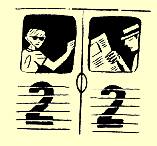Three major airports. Public bus lines. Private bus lines. The subway. And, of course, taxis. There are many ways to get to New York, and many ways to get around once you're there.
 The New York subway is dirty, noisy, intimidating and initially incomprehensible. It's also the fastest and most efficient method of getting from A to B throughout Manhattan and the Outer Boroughs, and it is a great deal safer and more user-friendly than it used to be. Put aside your qualms: an average of 3.6 million people ride the subway every day, quite a few for the very first time.
The New York subway is dirty, noisy, intimidating and initially incomprehensible. It's also the fastest and most efficient method of getting from A to B throughout Manhattan and the Outer Boroughs, and it is a great deal safer and more user-friendly than it used to be. Put aside your qualms: an average of 3.6 million people ride the subway every day, quite a few for the very first time.
One way to make yourself feel better right at the start is to familiarize yourself with the system when you first arrive. Pick up a free subway plan at any subway station (also at the information booth on the concourse at Grand Central, the New York Convention and Visitors Bureau at Columbus Circle, or any of the Visitors Information Centers). The basic guidelines will make more sense when you combine them with visual information.
Taxis are worth considering if you're in a hurry, in a group, or if it's late at night.
In Manhattan, there are two types: medallion cabs, immediately recognizable by their yellow paintwork and medallion up top, and gypsy cabs, unlicensed, uninsured operators who tout for business wherever tourists arrive. Avoid gypsy cabs like the plague as they're rip-off merchants - their main hunting grounds are outside usual tourist arrival points like Grand Central.
Up to four people can travel in an ordinary medallion cab - five if the driver's in a particularly good mood or if you're lucky enough to grab one of the last-remaining, old-fashioned Checker cabs. Fares are $2 for the first eighth of a mile, 30¢ for each fifth of a mile thereafter. Basic charges rise by 50¢ after 8pm, and by 100 percent if you're rich or foolish enough to take a cab outside the New York City limits (eg to Newark airport). Trips outside Manhattan can additionally incur toll fees; not all of the crossings cost money, however, and the driver should ask you which route you wish to take.
The tip should be ten to twenty percent of the fare; you'll get a dirty look if you offer less. Also likely to cause a problem is change: drivers don't like splitting anything bigger than a $10 bill, and anything bigger than a $20 will produce invective.
Before you hail a cab, it's always a good idea to work out exactly where you're going and if possible the quickest route there - a surprising number of cabbies are new to the job and some speak little English. If you feel the driver doesn't seem to know your destination, don't hesitate to point it out on a map. An illuminated sign on top of the taxi indicates its availability; if the small lights on the side of the sign are lit, it means the cab is off duty or on radio call and won't pick you up.
Officially there are certain regulations governing taxi operators. A driver can ask your destination only when you're seated - and must transport you (within the five boroughs), however undesirable your destination may be. You may face some problems, though, if it's late and you want to go to an outer borough. Also, if you request it, a driver must pick up or drop off other passengers, open or close the windows, and stop smoking (they can also ask you to stop). If you have any problems with a driver, get the license number from the right-hand side of the dashboard, or medallion number from the rooftop sign or from the print-out receipt for the fare, and phone the NYC Taxis and Limousine Commission on 302-8294. This is also the number to call if you realize you've left something in a cab.
 The New York subway is dirty, noisy, intimidating and initially incomprehensible. It's also the fastest and most efficient method of getting from A to B throughout Manhattan and the Outer Boroughs, and it is a great deal safer and more user-friendly than it used to be. Put aside your qualms: an average of 3.6 million people ride the subway every day, quite a few for the very first time.
The New York subway is dirty, noisy, intimidating and initially incomprehensible. It's also the fastest and most efficient method of getting from A to B throughout Manhattan and the Outer Boroughs, and it is a great deal safer and more user-friendly than it used to be. Put aside your qualms: an average of 3.6 million people ride the subway every day, quite a few for the very first time.